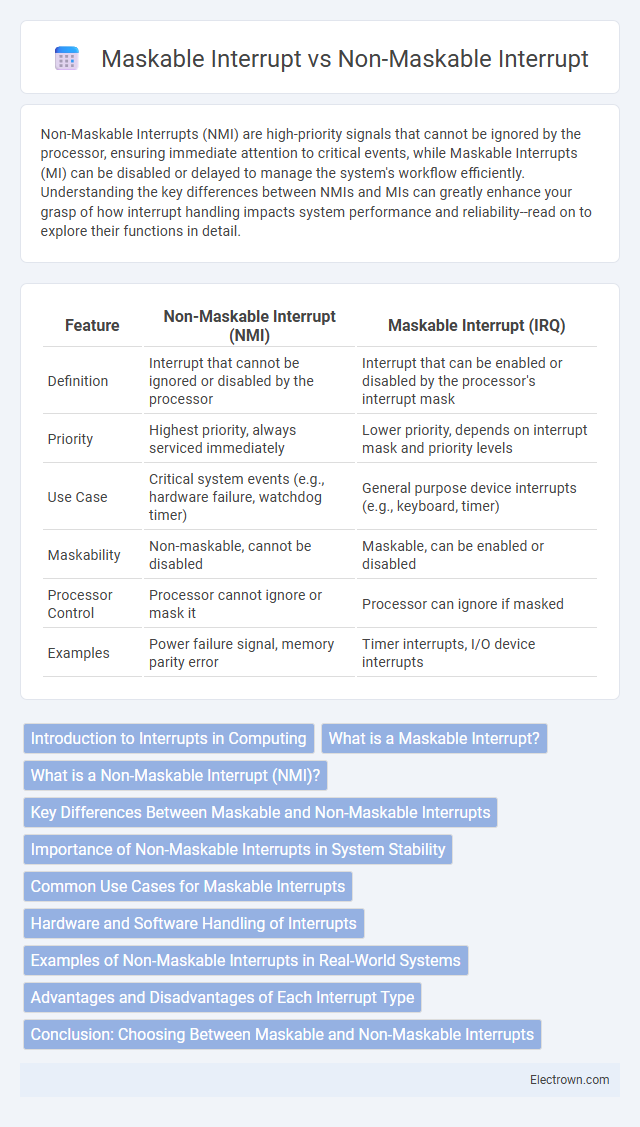Non-Maskable Interrupts (NMI) are high-priority signals that cannot be ignored by the processor, ensuring immediate attention to critical events, while Maskable Interrupts (MI) can be disabled or delayed to manage the system's workflow efficiently. Understanding the key differences between NMIs and MIs can greatly enhance your grasp of how interrupt handling impacts system performance and reliability--read on to explore their functions in detail.
Table of Comparison
| Feature | Non-Maskable Interrupt (NMI) | Maskable Interrupt (IRQ) |
|---|---|---|
| Definition | Interrupt that cannot be ignored or disabled by the processor | Interrupt that can be enabled or disabled by the processor's interrupt mask |
| Priority | Highest priority, always serviced immediately | Lower priority, depends on interrupt mask and priority levels |
| Use Case | Critical system events (e.g., hardware failure, watchdog timer) | General purpose device interrupts (e.g., keyboard, timer) |
| Maskability | Non-maskable, cannot be disabled | Maskable, can be enabled or disabled |
| Processor Control | Processor cannot ignore or mask it | Processor can ignore if masked |
| Examples | Power failure signal, memory parity error | Timer interrupts, I/O device interrupts |
Introduction to Interrupts in Computing
Interrupts in computing are signals that temporarily halt the CPU's current operations to address urgent tasks. Non-Maskable Interrupts (NMIs) have high priority and cannot be ignored or disabled by the processor, ensuring critical error handling or hardware failures are addressed immediately. Maskable Interrupts can be enabled or disabled by the system, allowing the CPU to manage routine tasks and prioritize processes efficiently.
What is a Maskable Interrupt?
A Maskable Interrupt (MI) is a hardware signal that can be ignored or delayed by the processor based on the current priority or settings in the interrupt mask register. It allows the CPU to temporarily suspend processing until higher priority tasks or system-critical operations are completed, enabling controlled multitasking and efficient resource management. Maskable interrupts are essential for handling regular events without disrupting critical processes, contrasting with Non-Maskable Interrupts (NMI), which must be processed immediately due to their high priority.
What is a Non-Maskable Interrupt (NMI)?
A Non-Maskable Interrupt (NMI) is a high-priority hardware interrupt that cannot be ignored or disabled by the processor's interrupt masking mechanism, ensuring immediate attention to critical system events. Unlike Maskable Interrupts, NMIs are used for urgent situations such as hardware failures, system errors, or watchdog timers that require prompt handling to maintain system stability. Understanding NMIs is essential for diagnosing and responding to severe hardware issues affecting Your device's performance.
Key Differences Between Maskable and Non-Maskable Interrupts
Non-Maskable Interrupts (NMIs) are high-priority system signals that cannot be ignored by the processor, ensuring immediate attention to critical hardware issues, unlike Maskable Interrupts (MIs) which the processor can enable or disable based on current processing needs. NMIs are typically used for urgent events like hardware failures, whereas MIs handle routine tasks such as input/output processing that can be delayed without system instability. Understanding these differences helps you design systems with appropriate interrupt handling for reliability and performance optimization.
Importance of Non-Maskable Interrupts in System Stability
Non-Maskable Interrupts (NMIs) are critical for system stability because they provide immediate attention to high-priority hardware failures or urgent events that cannot be ignored or delayed by the processor. Unlike Maskable Interrupts, which can be disabled or postponed by software, NMIs override all processes to ensure rapid response, preventing system crashes and data corruption. Your system's reliability depends on NMIs to handle fatal errors and maintain continuous operation in critical environments.
Common Use Cases for Maskable Interrupts
Maskable interrupts are commonly used in scenarios requiring flexible and prioritized handling of routine events such as keyboard input, timer expirations, and I/O device signals. These interrupts allow the processor to temporarily ignore lower-priority signals until higher-priority tasks are completed, ensuring efficient CPU utilization. Your system benefits from maskable interrupts by managing multiple asynchronous events without disrupting critical ongoing processes.
Hardware and Software Handling of Interrupts
Non-Maskable Interrupts (NMIs) are hardware-triggered signals that cannot be ignored or disabled by the operating system or software, ensuring immediate attention to critical events like hardware failures. Maskable Interrupts (MIs) are managed through interrupt masks controlled by the CPU, allowing software to temporarily enable or disable these interrupts based on priority and system state. Hardware prioritizes NMIs for urgent processing, while software routines handle Maskable Interrupts by saving context and executing predefined interrupt service routines.
Examples of Non-Maskable Interrupts in Real-World Systems
Non-Maskable Interrupts (NMIs) commonly occur in critical hardware failure scenarios like power failures, memory parity errors, or thermal overheating in systems such as embedded controllers and server CPUs, ensuring immediate attention to prevent data loss or damage. In contrast, Maskable Interrupts can be temporarily disabled by the CPU, allowing for routine processing tasks like keyboard inputs and timers in general-purpose computing. By understanding the distinct roles of NMIs, you can design fault-tolerant systems that prioritize urgent hardware signals effectively.
Advantages and Disadvantages of Each Interrupt Type
Non-Maskable Interrupts (NMIs) offer the advantage of immediate attention for critical system events, ensuring high reliability and responsiveness in handling hardware faults or emergency signals, but they can disrupt ongoing processes and complicate system design due to their non-deferrable nature. Maskable Interrupts (MIs) provide flexibility by allowing the CPU to ignore or delay interrupts during critical code execution, improving control and efficiency in multitasking systems, yet they risk missing urgent events if interrupts remain masked too long. Balancing NMIs and MIs optimizes system stability and performance by combining urgent fault handling with manageable task scheduling.
Conclusion: Choosing Between Maskable and Non-Maskable Interrupts
Selecting between maskable and non-maskable interrupts depends on the criticality of the event requiring immediate attention. Non-maskable interrupts (NMIs) are reserved for high-priority, non-deferrable conditions like hardware failures, ensuring your system responds instantly to prevent damage or data loss. Maskable interrupts provide flexibility by allowing your processor to prioritize and temporarily ignore less urgent signals, optimizing overall system performance.
Non-Maskable Interrupt vs Maskable Interrupt Infographic

 electrown.com
electrown.com